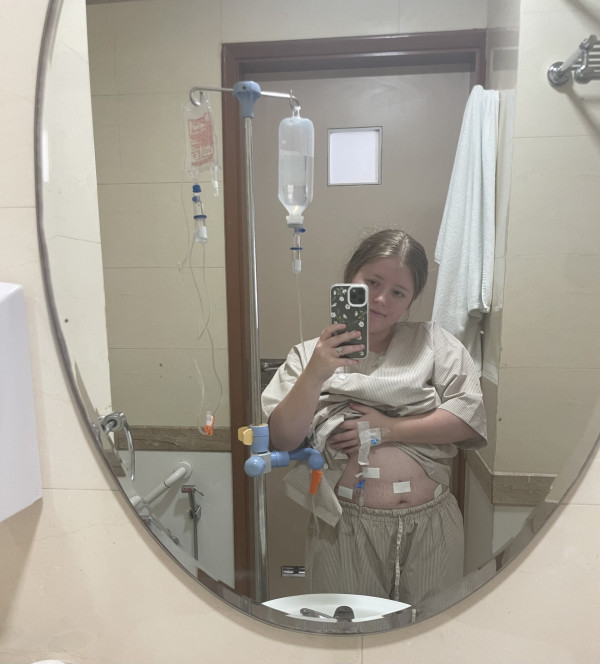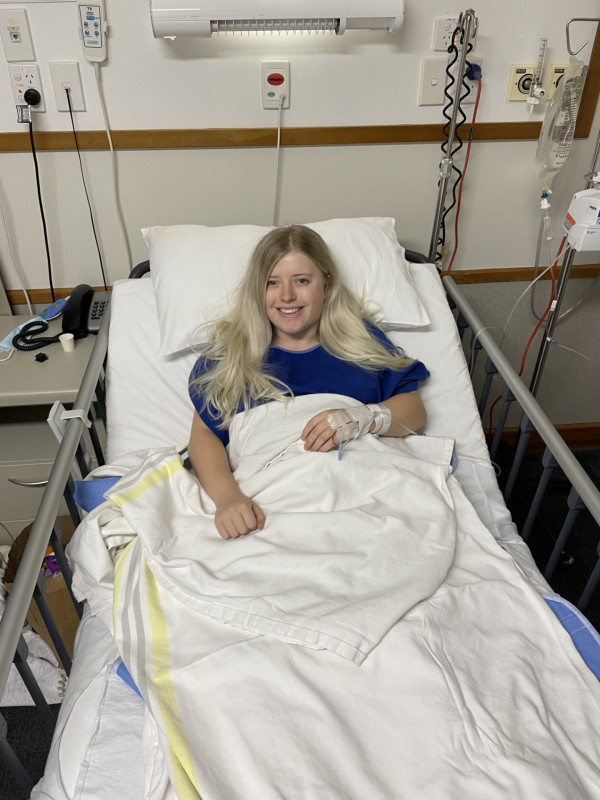Early detection of endometriosis is crucial for effective treatment. But despite 120,000 New Zealanders having the condition, it still takes an average of eight years to be diagnosed.
Kiarah Spellacey says the normalisation of painful periods got in the way of her being diagnosed early and has made it harder for her endometriosis to be treated. It’s now led her to go overseas for surgery, desperate to find relief.
Endometriosis New Zealand chief executive Tanya Cooke says people travelling overseas for treatment shows an endometriosis action plan is well overdue. But where is it?
Kiarah Spellacey remembers sitting in a geography class when everything around her got so blurry she could barely see.
She was only 15 years old at the time, but she knew the routine well. Get out of there and call mum.
As soon as Kiarah and her mum got to the car, Kiarah vomited all over the car park.
“I can't really remember what happened after that. I just remember thinking ‘it’s just my period’,” she says.

Kiarah has had five surgeries to help relieve her endometriosis. Photo: Supplied.
Kiarah has had brutal periods since she was 10 years old. Now at 23, those painful weeks she used to spend hiding at home all blend together.
“Endometriosis feels like someone is squeezing your insides and stabbing them constantly,” she says. “And it's not like period pain where you have a bad week, it's literally every day.”
What is endometriosis?
Endometriosis is a painful condition where cells similar to the lining of the uterus grow outside of the uterus.
Roughly 1 in 10 people with uteruses in New Zealand will have endometriosis - but despite how common it is, it takes years to be diagnosed.
Kiarah had symptoms of endometriosis even before her first period. One surgeon even told her she was probably born with it. But she didn’t get her diagnosis until she was 18.
She says the normalisation of painful periods is a big reason why it takes so long to be diagnosed.
Kiarah would regularly vomit, pass out and have large blood clots while on her period. Her nausea and pain were so intense she had to quit her job when she was 17.
A couple years down the track she pulled out of her nursing degree for two years because of her pain.
“Specialists would tell me my period pain was normal and not to worry. And I started to believe them, I thought maybe I’m just being dramatic,” she says.
“I would bring my mum with me to appointments and so she started to believe it was normal too.”

Kiarah in hospital. Photo: supplied.
Getting surgery
Kiarah’s pain had become so normalised, she says when she finally had her first endometriosis surgery she thought to herself ‘Oh my god, they're not even going to find anything and I'm just gonna waste their time’.
“But when I woke up, my surgeon said they found too much to remove so they had to plan a second surgery.”
Kiarah has now had five surgeries. Surgeons have found endometriosis in so many places she has lost track.
“I had appendicitis from endometriosis, so I had my appendix removed. I have a nodule on my rectum, behind my left ovary, my bladder, my bowel and behind my cervix,” she says.
Travelling to India for surgery
While her four surgeries in New Zealand have helped Kiarah, the relief was only temporary.
This is because there is no cure for endometriosis.
There are three types of surgeries offered in New Zealand for endometriosis: laparoscopy (where a small camera is inserted into the abdomen through small incisions to identify endometriosis, and other instruments are used to treat it), laparotomy (a major abdominal surgery that uses larger incisions than laparoscopy) and hysterectomy (a surgical procedure to remove the uterus).
But surgery does not always eliminate pain.
Health New Zealand chief medical officer Dr Nick Baker told Re: News: “Even if all the endometriosis has been removed, for about 20% of women, surgery has little impact.”
But Kiarah was so determined to find more help, she travelled to India to have her fifth surgery.
“I found the surgeon on social media and we were messaging for a few months. But the pain suddenly got so bad, we decided it needed to happen right away. I knew I couldn’t go back to nursing if I didn’t get the surgery,” she says.
Kiarah had surgery to remove the endometriosis on her bowel and bladder using robotics - a type of surgery she says she wasn’t offered in New Zealand.
All up the surgery cost her around $20,000, which she could only afford with the help of her parents and grandparents.
Advocates say the health system is failing people with endometriosis
Endometriosis New Zealand chief executive Tanya Cooke says New Zealand’s health system has “long failed those with endometriosis”.
The organisation provides support, advocacy, research and awareness on endometriosis for those who live with the condition and their communities.
While she can understand people are so desperate for help that they go overseas for treatment, Cooke says this option isn’t accessible to many people.
“We hear about people going overseas for treatment but these stories can be doom and gloom because it’s not an option for many. So it doesn’t really help, it just shows you how much we need better care here in New Zealand,” she says.
“There’s a lack of endometriosis education in primary healthcare, patients can experience long delays to see gynaecologists and other specialists, there is limited access to publicly funded ultrasounds, MRIs and hormonal treatment options, and there is no New Zealand network of tertiary referral centres for complex endometriosis surgery.”
Cooke says New Zealand urgently needs an endometriosis action plan.
“This would ensure early diagnosis and improved management of endometriosis symptoms for thousands of New Zealanders suffering from this debilitating disease,” she says.
A nation-wide action plan would mean a pool of money would be dedicated to increasing awareness of endometriosis within the health sector, investing in research, and improving clinical care across the country.
International research has found early treatment of endometriosis and associated pain may decrease the risk of developing chronic pain.
However, Cooke says a lack of awareness and research means endometriosis is a “commonly misunderstood condition” and this can delay or get in the way of effective treatment.
That’s why for Endometriosis Awareness Month, which runs in March, Endometriosis New Zealand is campaigning to raise awareness “on the basics of endometriosis, understanding the signs and symptoms to support early diagnosis and managing the condition”.
There are action plans for other health issues in New Zealand.
For example the New Zealand Cancer Action Plan 2019–2029 which aims to improve cancer outcomes and early detection, the Suicide Prevention Strategy and Action Plan to reduce suicide rates and provide mental health support and the New Zealand Antimicrobial Resistance Action Plan which aims to improve awareness of antimicrobial resistance and the importance of using antibiotics appropriately.
So where is New Zealand’s endometriosis action plan?
During Labour’s election campaign in 2023, the party said it would develop an action plan to implement endometriosis education and awareness, improve clinical management and care, and support focused research initiatives.
However, despite the new government saying “there is a considerable focus on improving endometriosis care”, Associate Health Minister Casey Costello told Re: News she hasn’t “yet had a full briefing on this issue from the Ministry of Health”.
“At this stage I don’t believe an ‘Action Plan’ would deliver an immediate benefit to the women who suffer from endometriosis,” Costello said.
“Across the board we need to make sure that the services government provides and funds provide the best care and results for people and I’m more interested in knowing that services work effectively than seeing effort put into producing strategy documents.”
Health New Zealand chief medical officer Dr Nick Baker says while there is currently no endometriosis action plan, clinicians are encouraged to use the Diagnosis and Management of Endometriosis in New Zealand guidance which was created in March 2020.
“The guidance aims to support early recognition of symptoms and empower primary health care practitioners to make a diagnosis and commence management.
“Referral to secondary care gynaecological services is only advised if the patient has uncontrolled symptoms that have not responded to treatment options in primary care.”
However Cooke says the issue is there was no funding put behind this document.
"Despite the Ministry of Health's publication of best practice guidelines in 2020, the lack of an endometriosis national action plan in New Zealand reflects a concerning gap in addressing the needs of the thousands affected by this condition,” Cooke says.
“It's imperative that we prioritise funding, resources and urgent progress in diagnosis, treatment, and care, ensuring equitable access and support for all individuals impacted by endometriosis across the country."
Cooke says it feels “disappointing” to hear the new government won’t be prioritising a national action plan.
‘The health sector needs to take pain seriously’
Desperate for a way to manage her endometriosis, Kiarah has tried different birth control methods, medically inducing early menopause, and surgery after surgery.
But she has come to accept her endometriosis is a “lifelong thing”.
She says while more research is needed to find a cure, preventing more people from being diagnosed late could save people from a lifetime of chronic pain.
“It’s just terrible how [the health sector] doesn’t really take women’s pain seriously. I was made to feel like I was being dramatic, or I was stupid. But if I was taken seriously, things might be different.”